The Victorian fishing scene comes alive towards the end of September. This is the time of year we anglers look forward too, with warm early mornings, calm waterways and plenty of hungry snapper waiting for a bait tossed into their domain.
Throughout the season, anglers from all levels of experience head out to try their luck. Some have instant success while others plod around, wondering what they are doing so different to others that are successful.
When it comes to selecting good snapper baits, there are plenty that are recommended. The best piece of advice I can give is to take a selection of different baits out with you. You never know which will be favoured on a particular day. Depending on where you are fishing, different baits will work in different areas. Calamari and pilchards are two baits you have to take out on every trip.
Fresh calamari is a killer bait, but not all of us have the time to go bait gathering before searching for a red. This is where bait collection over the winter/spring months pays off. I use this time, like many keen anglers to stock up on calamari for the season.
To keep them as fresh as can be, they are frozen down in sealable bags of saltwater. This prevents freezer burn and keeps them from deteriorating.
Aside from pilchards and calamari, frozen USA boxed squid is a great alternative but have found it to work better with the head removed and a pilchard trunk stuffed into the hood.
If you’re fishing in Western Port, sauries, calamari, pilchards, garfish, barracouta fillet, salmon fillet, mullet fillet, tuna and cured freshwater eel works a treat. The oil content in these baits continually expels in the current, attracting fish to the source. These baits can be fished in numerous ways, whole, as strips, fillets or chunks.
In Port Phillip, pilchards, silver whiting, sauries, garfish and calamari are the most common. Depending on what section you are fishing, these baits are prime in the upper reaches from Mornington to the Yarra. If you’re fishing the southern end, you might want to revert to the baits recommended for Western Port as the tide flow is stronger and you’ll want your bait to sit straight in the current rather than spinning as whole baits do.
When it comes to rods and reels the decision is never ending but I’d look for something up to the task. While a $20 combo will catch a fish or two, I bet the drag is lumpy and the line is stretched leaving you a good candidate for busting off the next brute that takes the bait.
Due to the force of the current in Western Port and southern Port Phillip and amongst some tough bottom feeders, it is suggested you have a reel with a very good drag. Reels from well-known quality brands will give years of good service if well looked after – your local tackle specialist will have an excellent range to look at combined with specialist advice.
There are many reel brands out there that will do the job but you want your reel to last without a hiccup. Look for a reel that supports a high drag rating so you’re not left to battle out a brute for too long or for the reel to break under heavy strain, especially in strong tidal locations.
Reels should have the capability of fishing 30-50lb braid which is the norm if you’re fishing these waters.
As for rods to mount them on, look for something in the 8-12kg or 10-15kg range. You can’t go wrong with the inexpensive Ugly Stick range nor the IFISH Western Port model. These can be considerably bashed around and will stand up to the challenge if you’re a heavy-handed angler. There are also some very good rods from a range of respected manufacturers that will give years of quality service.
When you’re fishing these areas you will no doubt be using heavy sinkers from 10-20oz. Some lighter model rods won’t handle this pressure with the sinker let alone a 5kg red on the other end.
In Port Phillip you can lighten up considerably. Considering there is a lack of tide, sinker weight can be kept to a size 1 ball that will allow you to comfortably fish rods around the 4-6kg or 6-8kg ratings. Graphite rods can really shine here giving you longer fights with rods that are about half the physical weight of their glass cousins.
For reels, I prefer to fish 4 and 6kg line class so my reels are relatively small in the scheme of things, around the 4000 series reel will hold a good 250m of 4kg braid, more than enough for a sizeable red. For most anglers fishing Port Phillip, the standard is a 3000-4000 reel.
With all the aspects of fishing, the last thing you don’t want is to lose any fish you hook, so don’t go cheap on terminals, and especially hooks. Snapper have quite a strong bony mouth, thus your hook selection is crucial. When you hook a snapper, you want the hook to imbed with little interference from yourself.
Limiting the amount you have to strike will gain a more solid hook set which can eliminate your need to strike.
There are myriad hook brands on the market and as long as they are chemically sharpened, they will do the job. Some mid-price brands (even though they are chemically sharpened) can become blunt on a fish which may result in making it harder to imbed the hooks into another fish.
The finer points on hooks can snap off or become round when rubbing on bone so be wary and inspect your hooks after every fish. If you don’t mind spending the extra 20 or so cents on purchasing better quality hooks, look at the Black Magic, Instinct or Owner Range, these won’t let you down.
In Western Port, I use quite heavy terminal tackle to combat the current and hard-fighting by-catch. The last thing I need is to spend 40 or so minutes tight to a stingray while I have a hot snapper bite.
In Western Port I use two rigs, a paternoster rig which is a pre-tied Black Magic Snapper Snatcher. This rig is baited with either two half pilchards (tail end) or strips of calamari.
It is left to sit in a rod holder with limited drag and it is a bait that I can leave during the duration of my session. The other is a running sinker rig made from a 1m length of 80lb tough trace. This supports adequate abrasion resistance when fishing over heavy reef or should you hook a gummy shark, sting ray or seven-gill shark as a by-catch.
On the top end of the leader I have a rolling swivel to prevent line twist unlike the brass models, which can tangle everything. On the opposite end, I attach the hooks. For this I prefer to use a single 6/0 Black Magic circle hook or snelled 5/0 suicide hooks.
This setup allows a bait to sit straight and waft as if it is a dead fish flowing with the current. Using one or two hooks prevents the bait from spinning in the current, which may spook fish.
In the northern sections of Port Phillip my setup is a little different. I scale down my tackle down fishing only 4kg monofilament rather than braid. Having very little current, I want my baits to slowly sinking towards the bottom but keeping them in the strike zone for as long as possible.
This can be achieved by having a small size 1 ball, barrel or bean sinker freely running on the leader line between the swivel and the hooks. My leader is 30lb fluorocarbon for its abrasive resistance and my hook setup is two suicides in a 6/0 size. The first hook is threaded onto the leader through the top of the eye and the second hook tied on from the bottom of the eye with a uni knot. This allows me to place the sliding hook wherever I like into the bait while the fixed bottom hook is embedded into the head of the bait.
Being able to move the running hook allows me to change it to where I find the snapper are taking the bait. On occasion, I have had snapper take the bait from between the hooks, then by moving the hook further down the body, begin to hook-up.
While each and every angler will do things different to one another, my techniques have served me well over past years. Whatever the scenario, by rigging it right, using the right gear and bait selection you too can enjoy the benefits of a good 2010 snapper season.
Next issue, we will dive into the world of sounding, anchoring and setting up your boat so stay tuned.
Reads: 47652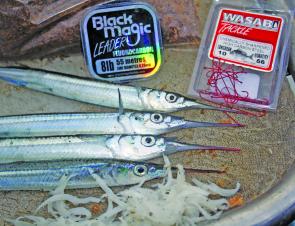
Garfish caught fresh are a gun bait for snapper.
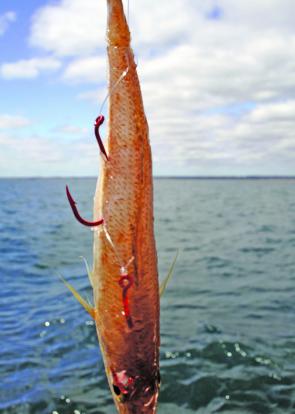
Silver Whiting are a popular bait for Port Phillip Bay, although purchased frozen, they can be caught fresh in Bass Strait.

Whole calamari head work well for big snapper.
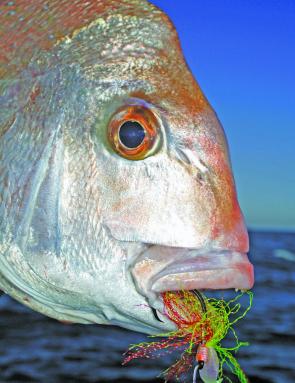
Black Magic Snapper Snatches are a popular rig. Complete with a super sharp circle hook, they are deadly.

When you use good quality hooks, it is hard for the fish to get away.
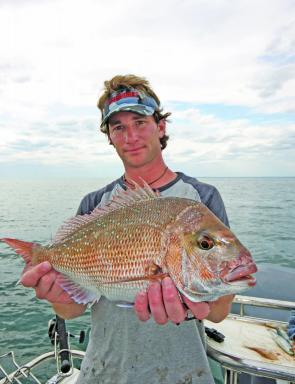
Using a combination of fresh bait and quality terminal tackle use the undoing of this nice size pinkie snapper.

When you get onto a patch of fish, it isn’t uncommon to catch cricket score numbers of fish. This is where it pays to regularly check your hooks in case a big fish takes the bait and the hooks are blunt.
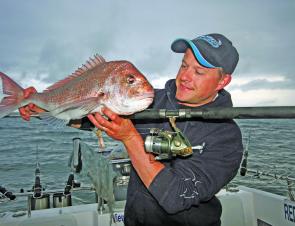
Reels like the bait runner or 4000 series spin reels are ideal when snapper fishing in Port Phillip Bay.




